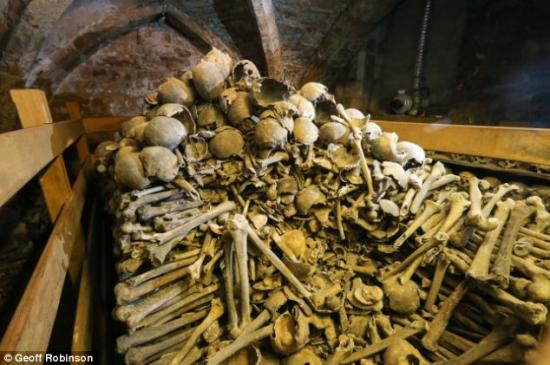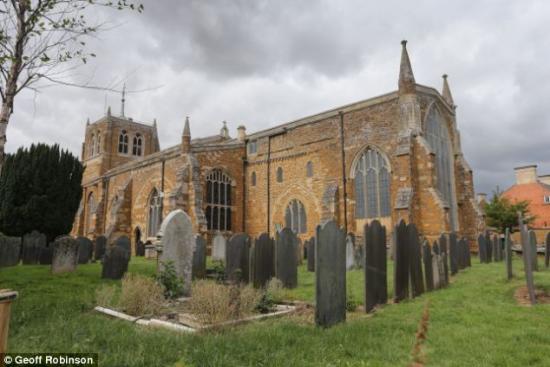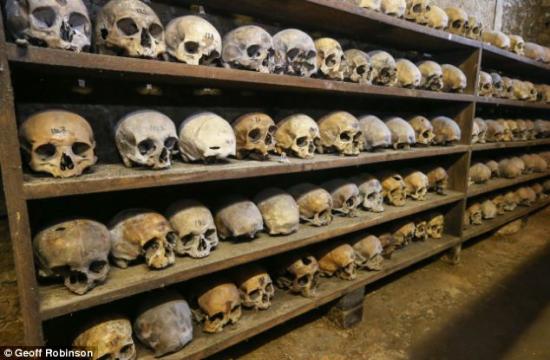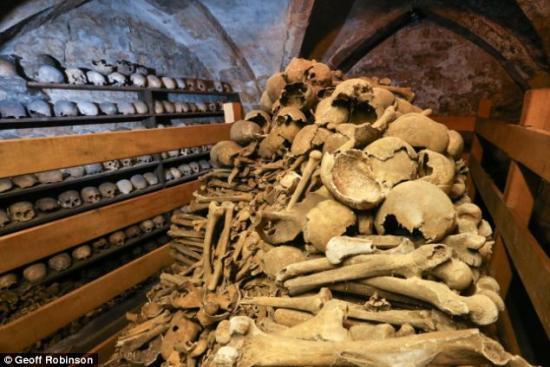Chapel storeroom containing hundreds of jumbled skeletons was a place of pilgrimage and not remnants of a plague pit
University of Sheffield researchers suggest the crypt was a medieval monument for pilgrims and villagers who prayed among the bones
Villagers have long believed the skeletons at the Holy Trinity Church in Northamptonshire, were victims of the plague or soldiers
At one time there were believed to have been hundreds of bone crypts all over Britain, but they were lost during the Reformation
Sarah Griffiths / Jo Riley
Source - http://www.dailymail.co.uk/sciencetech/article-2391375/Holy-Trinity-Church-Rothwell-Chapel-contains-hundreds-skeletons.html#ixzz2brew7Kj4
The secret of a 700-year-old bone crypt under a village church, which is stacked with hundreds of skeletons, has been solved by a team of scientists.
The 13th Century charnel chapel, one of only two in the UK, contains the remains of around a thousand people and has been shrouded in mystery for more than seven centuries.

Villagers have long believed the disarticulated skeletons at the Holy Trinity Church in Rothwell, Northamptonshire, were victims of the plague or soldiers from the nearby battle of Naseby.

Now research by experts at the University of Sheffield's Department of Archaeology suggests the crypt, which looks like something from a Hollywood horror film set, was a medieval monument for pilgrims and villagers who prayed among the bones of their ancestors.
'There have been rumours surrounding the bones for hundreds of years and I wanted to put them to rest and work out the real reason why the crypt was built,' said Jenny Crangle, an osteo-archaeologist.
'Many people believed it was used as a sort of rubbish bin to get rid of unwanted human remains, such as plague victims, but actually I think it was a place of pilgrimage.'

At one time there is believed to have been hundreds of bone crypts all over Britain, but they were lost during the Reformation.
This one was re-discovered in 1700 by accident when a grave digger fell into the bone house and came across the skeletons.
Since then stories have grown about who the skeletons are and why they got there.

Ms Crangle, who has been researching the ossurie for five years, has been using modern scientific techniques to solve the medieval mystery of the bones, which include 800 human skulls.
'All the theories stemmed from 1700, so we have been using modern methods to try and unpick them,' she said.
'We know the bones did not belong to soldiers as they are a mix of men and women and the marks which people thought were battle scars were actually made after they were dead.
'We also know they are unlikely to have been plague victims as people who died from the plague were given the same burial rights as everyone else and no one would have wanted to dig them up and move them.'
She said there had also been a rumour that the crypt only contained femurs and skulls, but in fact it contained complete skeletons at one time.
'We now believe there would probably have been hundreds of these crypts around the country at one time and they were a place for people to visit and pray for the dead,' she said.
'We believe the bones were moved into the crypt from graves, but they could have come from lots of different cemeteries.'
Ms Crangle and her team now hope to secure funding to use carbon dating techniques to work out the age and sex of the victims and where they were from.
'It has been a very exciting project so far and we want to continue to find out more about the skeletons,' she said.
'For hundreds of years people have had the wrong impression about the crypt and seen it as a horrible place, but for medieval people it would have been a religious place to visit, much like going to a grave today.'